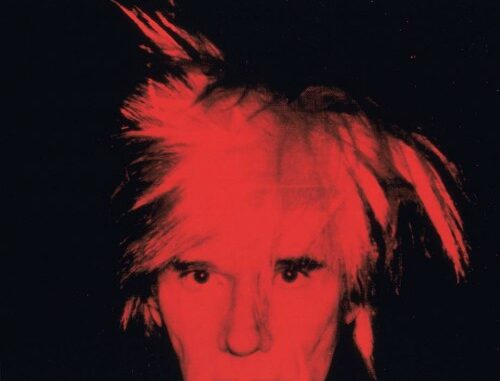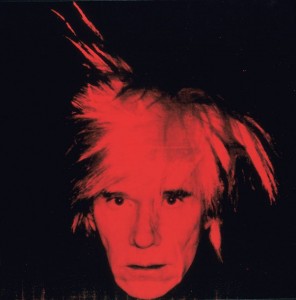

In a room at the end of the Graves Gallery in Sheffield hangs a small collection of works Andy made towards the end of his life. The exhibition is comprised of, among other works, the well-recognised 1986 large screen prints, death-centred paintings and a collection of photographs of Andy in drag. There are also recordings of friends, family and colleagues talking about Andy’s life and art, which are much the same thing.
Around Sheffield, spray-painted onto pavements, are vivid graphics advertising the exhibition. In block pink and green text, they are fluorescent and unmissable. This contrasts somewhat to the exhibition itself, which does not recall the Warhol most people will be familiar with. This is not an exhibition of hallucinatory cow wallpaper, flowers, or clouds of silver balloons created in a tinfoil ‘Factory’ that was the cool nexus of socialites, drag queens, rock music and amphetamine.
But there is nothing disappointing about this late work. The 70s marked a lull in Andy’s critical reception, and though the 80s heralded a resuscitation of artistic and financial success, Andy was still tarred with critics’ comments that he had become too much of a ‘business artist’. Warhol himself said that ‘being good in business is the most fascinating kind of art. Making money is art and working is art and good business is art.’ If critics were repulsed by the commerciality and superficiality of Warhol’s oeuvre, it was only because they were repulsed by the commerciality and superficiality of their (and therefore our) times.
There is something else seeded in these artworks too. Something deeper. They contain a silent, solemn and even sinister ambience. In 1968 when Andy was shot by Valerie Solanas, he was declared clinically dead before being revived in a bloody and meticulous operation that left his body horribly scarred. He said that the assassination attempt proved to him that life was ‘watching television’. The juxtaposition of this real bodily horror with Andy’s witty, everyday allegory typifies this collection, which are both profound reminders of, and playful resisters to, death.
A truism to mention, but the focus on the self-portraits really is significant. Famous for Marilyn, Taylor, Jackson, Mao, Kennedy and many, many more, this exhibition is a simple and refreshing insight into the man himself. Who was he? What was he like, truly? Undoubtedly a genius, Warhol often wore masks which were, not unlike his art, products. Here is an exploration of the man under the wig, the man behind the apparently surgically-attached sunglasses. From the unavoidable raw presence of his massive, looming crimson screen-print to the hilarious photographs of him in drag, there is both presence and absence of the artist, the observer, the entrepreneur, the human being.
Another of Andy’s aphorisms: ‘People are always calling me a mirror and if a mirror looks into a mirror, what is there to see?’ I think this fascinating exhibition is successful in providing two answers. The first, more obvious answer of ‘nothing’ is scintillating enough a concept on its own. The second answer is of course infinity; everything repeated forever. The exhibition will not only have you pondering Andy’s nothings and everythings, but your own.
The exhibition is running from Wednesday 11 April 2012 to Saturday 1 December 2012
Wednesday–Friday 10am–3pm
Saturday 11am–3pm
Closed Bank Holidays
Free Entry
Graves Gallery
Surrey Street
Sheffield
S1 1XZ

Leave a Reply